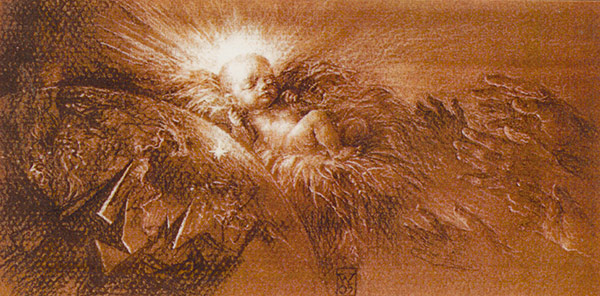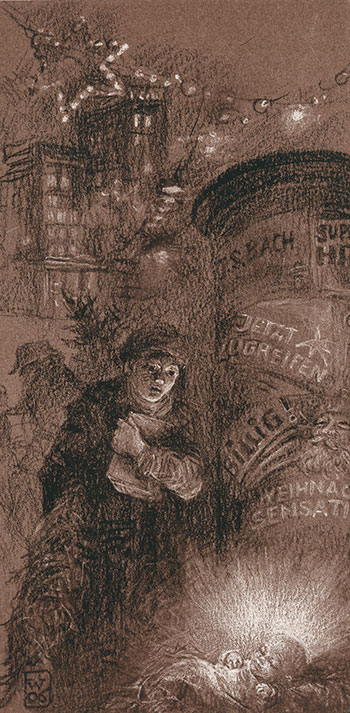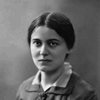Subtotal: $
Checkout
The Mystery of Christmas
Where now are the jubilant sounds of the heavenly choir? Where the peaceful bliss of the Holy Night? Where is the peace on earth?
By Edith Stein
December 25, 2022
Edith Stein, a Jewish convert to Christianity who was later executed in the Auschwitz concentration camp, gave the talk from which this reading is taken in 1931.
Advent and Christmas
When the days grow shorter and shorter, when – in a normal winter – the first snowflakes fall, then quietly and softly thoughts of Christmas begin to surface, and from the mere word a certain magic exudes that affects every heart. Even those of other faiths, or of no faith at all, to whom the story of the Child of Bethlehem has no meaning, prepare for the feast and even make plans to convey its joy here or there. Months and weeks in advance, there flows a warmth like a stream of love over the whole world. A festival of love and joy – that is the star which beckons all humankind in the first winter months.
For Christians, and especially for Catholic Christians, it is yet something else. The star leads them to the manger with the little Child who brings peace to the earth. In countless endearing pictures, artists have created the scene for our eyes; ancient legends, replete with all the magic of childhood, sing to us about it. Whoever lives along with the Church hears the ancient chants and feels the longing of the spirit in the Advent hymns; and whoever is familiar with the inexhaustible fount of sacred liturgy is daily confronted by the great prophet of the Incarnation with his powerful words of warning and promise:
Drop down dew from above and let the clouds rain the Just One! The Lord is near! Let us adore him! Come, Lord, and do not delay! Jerusalem, rejoice with great joy, for your Savior comes to you!
From December 17 to 24, the great O Antiphons to the Magnificat call out with ever greater longing and fervor their “Come, to set us free.” And with still more promise (on the last Advent Sunday), “Behold, all is fulfilled,” then, finally, “Today you shall know that the Lord is coming and tomorrow you shall see his splendor.”
Yes, on that evening when the lights on the tree are lit and the gifts are being exchanged, that unfulfilled longing is still there groping for another ray of light until the bells for Midnight Mass ring out, and the miracle of the Holy Night is renewed upon altars bedecked with lights and flowers: “And the Word was made flesh.” Now the moment of blessed fulfilment has arrived.
The Followers of the Incarnate Son of God
Each of us has no doubt already experienced such Christmas bliss. Still, heaven and earth are not yet united. The star of Bethlehem remains a star in the dark night even today. On the day after Christmas the Church removes her white garments and clothes herself in the color of blood, and on the fourth day in the violet of mourning: Stephen, the first martyr, the first to follow his Lord to death, and the infants of Bethlehem and Judea who were brutally slaughtered by crude henchmen, all have a place around the Child in the manger. What is the meaning of this message? Where now are the jubilant sounds of the heavenly choir? Where the peaceful bliss of Holy Night? Where is the peace on earth? Peace to those of good will; but not all are of good will. Therefore, the Son of the eternal Father must leave the splendor of heaven, because the mystery of evil has wrapped the earth in dark night.

Illustration by Christoph Wetzel
Darkness covered the earth and he came as light to illumine the darkness, but the darkness did not comprehend him. To those who received him, he bought light and peace; peace with the Father in heaven, peace with everyone who like them are children of light and children of the heavenly Father, a deep interior peace of the heart; but no peace with the children of darkness. To them the Prince of Peace does not bring peace but the sword. He remains for them the stumbling block of scandal against which they charge and are smashed. That is the one hard and serious fact which we may not allow to be obscured by the visible attraction of the Child in the manger. The mystery of the Incarnation and the mystery of evil belong together. The dark night of sin stands in stark and sinister contrast with the Light which came down from heaven. The Child in the manger extends his little hands and his smile seems to be saying what would come forth later from the lips of the Man: “Come to me all you who are weary and heavy burdened”; and the poor shepherds out on the hills of Bethlehem, who heard the good news of the angel, follow his call and make their way with the simple answer, “Let us go to Bethlehem.” Upon the kings from the orient lands, who followed the wondrous star with similar simplicity, the Infant’s hands also dropped the dew of grace and “they rejoiced with great joy.” These hands give and request at the same time: you wise men, lay down your wisdom and become like children; you kings, give up your crowns and your treasures and bow down meekly before the King of kings; do not hesitate to take up the burdens, sorrows, and weariness which his service demands. You children, who as yet cannot give of your own free will, of you these little hands will request your gentle life before it has even begun; it can serve no better purpose than sacrifice in praise of the Lord.
“Follow me,” say the little hands, words which later would come from the lips of the Man. Thus they spoke to the disciple whom the Lord loved and who is now also part of the group at the manger. Saint John, the young man with the pure, youthful heart followed without asking, “Where to? Why?” He left his father’s boat and went with the Lord along all his ways, even to Golgotha. “Follow me” – young Stephen also understood this. He followed the Lord in the struggle against the powers of darkness, the blindness of obstinate unbelief; he bore witness to him with his word and his blood; he followed him in his spirit, the spirit of love, which resists sin but loves the sinner, and even in death intercedes with God on behalf of the murderer. These are the figures of light who kneel around the manger: the gentle, innocent children, the faithful shepherds, the humble kings, Stephen, the enthusiastic youth and beloved apostle, John – all of them followed the call of the Lord.
Only this do we know: that for those who love the Lord, all things work out for good. And in addition, that the paths which the Lord directs lead out beyond this earth.
In contrast to them, there is the night of incomprehensible callousness and blindness: the scribes who have information as to the time and place where the Savior of the world is to be born, but who say nothing about “Let us go the Bethlehem!” and King Herod who wants to kill the Lord of Life. In the presence of the Child in the manger, the spirits line up to take sides. He is the King of kings and Lord of life and death. He utters his “follow me” and whoever is not for him is against him. He also speaks for us and invites us to choose between light and darkness.
Oneness with God
Where that will lead us on this earth we do not know and should not ask beforehand. We only know this: that for those who love the Lord, all things work out for good. And in addition, that the paths which the Lord directs lead out beyond this earth.
O wonderful exchange! The Creator of humankind, by taking on a human body, imparts to us his divinity. It is for this wondrous task that the Savior came into this world. God became a child of man so that the human race could become children of God. One of our race severed the bond of our divine adoption: one of us had to bind it up again and pay for the sin. No one from the ancient, sick, and degenerate race could do it. A new, healthy, and noble sprout had to be grafted. He became one of us; but even more than that; one with us. That is precisely the wonderful thing about the human race – that we are all one. If it were otherwise, were we all to exist as independent and separate individuals, then the fall of one could not have brought about the fall of all. Then, on the other hand, the price of sin could probably have been paid for us and charged to us, but his justification would not have passed on to sinners; no vindication would have been possible. But he came to be a mysterious Body with us: he as head, we as members. Let us place our hands in the hands of the divine Child, let us speak our “yes” to his “follow me.” Thus we shall be his and the path shall be open for his divine life to pass over upon us.

Illustration by Christoph Wetzel
That is the beginning of eternal life in us. It is not yet a blessed entrancement in the light of glory. It is still the darkness of faith, but it is no longer of this world; it is already a stance in the kingdom of God. When the ever blessed Virgin spoke her “Fiat,” it was the beginning of the kingdom of God on earth and she was the first handmaid. And all who before and after the birth of the Child recognized him in word and deed – Saint Joseph, Saint Elizabeth with her child, and all those standing around the manger – entered into the kingdom of God. Things changed since the reign of the divine King was interpreted in terms of the psalms and the prophets. The Romans remained the rulers of the land and the high priests and scribes continued to keep the poor people under their yoke. Anyone who adhered to the Lord carried his heavenly treasure invisibly within himself. His temporal burden was not removed from him; on the contrary, many others were added. Yet, what he bore within himself was an exhilarating strength which softened the yoke and lightened the burden. This remains true today for every child of God. The divine life which is enkindled in the soul is the Light that came into the darkness – the mystery of the Holy Night. Those who bear it within themselves understand its meaning. For others, on the contrary, it remains an enigma regardless of any explanation. The entire Gospel of St John concerning the eternal Light which is Love and Life deals with it. God is in us and we in him; that is our portion of the kingdom of God, established by the Incarnation.
Oneness in God
One with God: that is number one. However, a second proceeds from this. If Christ is the Head and we the members in the Mystical Body, then we relate to each other as member to member and we are all one in God, a divine life. If God is in us and if he is Love, then it cannot be otherwise but to love one another. Therefore, our love for our brothers and sisters is the measure of our love for God. But it is different from a natural, human love which affects this one or that one who may be related to us, or who may be close to us because of the bonds of temperament or common interests. The rest are “strangers” who don’t concern us, perhaps even by their presence annoy us, so that love is kept as far away as possible. For the Christian there is no “strange human being.” He is in every instance the “neighbor” whom we have with us and who is most in need of us. It makes no difference whether he is related or not, whether we “like” him or not, whether he is “morally worthy” of help or not. The love of Christ knows no bounds, it never ceases, it never withdraws in the face of hatred or foul play. He came for the sake of sinners and not for the righteous. If the love of Christ lives in us, then we do as he did and seek after the lost sheep.
Natural love seeks to possess the beloved entirely and as far as possible not to share him. Christ came to win back lost humankind for the Father; whoever loves with Christ’s love will want people for God and not for himself. Of course, that is the surest way to possess them forever; for whenever we have entrusted a person to God, we are one with him in God, whereas the craving to overpower sooner or later always leads to loss. This is true for the other’s soul as well as for one’s own and for every external possession. Whoever is evidently out to win and possess, loses; whoever hands over to God, wins.
Thy Will Be Done!
With that we touch upon a third sign of the child of God. To be one with God was the first; that all may be one in God, the second. The third: “By this do I know that you love me; if you keep my commandments.” To be a child of God means to go hand-in-hand with God, to do his will, not one’s own; to place all one’s hopes and cares in his hands and no longer be concerned about one’s self or future. Thereupon rest the freedom and the good cheer of the child of God. Yet how few of the truly devout, or even those truly heroic and willing to make sacrifices, possess them. They always go around bowed down under the heavy burden of their worries and responsibilities. They are all familiar with the parable of the birds in the sky and lilies of the field. But whenever they encounter anyone who has no means, nor income, nor insurance and is nonetheless unconcerned about the future, they shake their head, completely baffled. Of course, anyone who expects that his heavenly Father will always see to it that he is well off and well taken care of could very well be greatly mistaken. Trust in God will remain unshakably firm only if it is willing to accept from the Father’s hand anything and everything. He is the only one who knows what is good for us. And if, sometime, need and want are more in order than a pleasantly comfortable living, or misfortune and humiliation rather than honor and prestige, one must be prepared for that as well. If this can be done, one can freely live for the present and for the future.
Edith Stein, The Mystery of Christmas: Incarnation and Humanity (1931), trans. by Sr. Josephine Rucker SSJ (1950). Used by permission.
Already a subscriber? Sign in
Try 3 months of unlimited access. Start your FREE TRIAL today. Cancel anytime.






